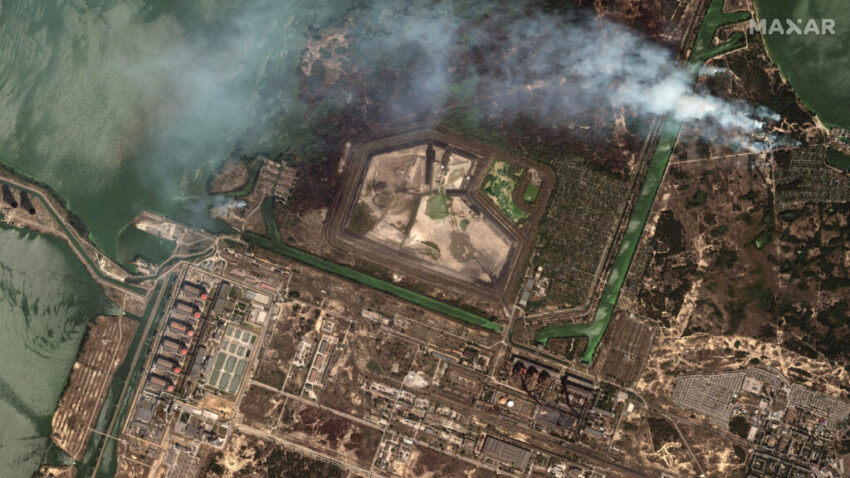Satellite imagery taken by Maxar Technologies on Aug. 29, 2022 shows the Zaporizhzhia nuclear plant in Ukraine. (Satellite image ©2022 Maxar Technologies)
WASHINGTON — Expected cuts to budgets for commercial satellite imagery used increasingly by the military, Intelligence Community and national weather organizations are threatening the financial stability of the US remote sensing ecosystem as a whole, according to a number of industry representatives and market watchers.
“The long-term health of the U.S. commercial remote sensing industry and the billions of dollars in private investment is being put at risk by rumored cuts,” David Cavossa, head of the Commercial Space Federation, told Breaking Defense.
Caleb Henry, an analyst at Quilty Space, said that US commercial remote sensing satellite operators are looking at a much weaker US market demand across all sectors — military, civil and commercial — for their products.
“Commercial satellite operators have already had a challenging go of it the past few years, and that’s because so many were optimistic that the commercial market would blossom for them, but it hasn’t. And when that didn’t occur, it put more pressure on them to step up or shore up other parts of the business, which meant going to [the Defense Department]. And as you know, DoD likes the commercial sector, but doesn’t want to be the sole reason for its existence,” he said.
“So, you have a commercial market that has been underwhelming. You have a core government customer that is faltering in its level of demand,” Henry added.
For the US national security arena, wary eyes have been watching the commercial space budget for the National Reconnaisance Office (NRO). The White House has yet to provide Congress with a formal federal budget proposal for FY26. Agency officials are not permitted to publicly discuss their individual agency budgets. Further, NRO’s budget is classified.
However, industry and congressional staffers have been getting informally briefed on the “passback” documents from the Office of Management and Budget (OMB) to federal agencies that include changes to their requests, according to industry and hill sources.
As first reported by Space News, industry representatives said they have been warned by NRO to expect a drop of up to 30 percent in its spending on commercial imagery under its Electro-Optical Commercial Layer (EOCL) program launched in 2022 with contracts Maxar Technologies, BlackSky and Planet. (Electro-optical satellites use visible light cameras to take pictures of things on Earth.) If all options were to be exercised by NRO, those contracts would be worth about $4 billion over the next 10 years.
When pressed by lawmakers earlier this month, NRO Director Chris Scolese declined to confirm or deny that cuts are on the way, only saying the NRO “very much value[s] the commercial capabilities and intend to keep on using those.” (An agency spokesperson declined to comment to Breaking Defense at the time.)
Quilty has previously reported that the spy satellite agency’s annual commercial remote sensing spending around the $400 million mark — where it’s believed to have hovered for several years — with most going to the three EOCL providers.
About $10 million or so of that total is spent on the 17 other commercial imagery/data study contracts under NRO’s Strategic Commercial Enhancements Broad Agency Announcement (SCE BAA) program for acquisition of remote sensing data from satellites using different types of sensors and/or novel data processing techniques.
Meanwhile, budget documents posted Friday on NASA’s website confirm that the agency’s FY26 science budget totals $3.9 million, down from $7.3 million in FY25. And according to widespread media reports, the National Oceanic and Atmospheric Administration, which monitors various climate factors and provides free weather forecasting, may see nearly a third of its budget whacked as well.
A number of US commercial remote sensing firms, including Maxar and Planet, take in revenue from NASA and NOAA that in other circumstances could have provided a cushion for any NRO cuts.
With cuts apparently on the horizon, one company official said that it isn’t clear that the Trump administration has digested the fact that taken together, the proposed reductions in NRO, NASA and NOAA spending on remote sensing data are going to be a body blow to American space companies.
“All of these speak to a contracting of commercial space industry,” said the official, who requested anonymity to speak frankly. “I don’t know that anybody, without a National Space Council, is actually looking horizontally across all these little decisions that are being made, and understanding the broader impact to the to the industry, the marketplace.”
Indeed, a number of commercial space industry representatives stressed that the expected cuts contradict President Donald Trump’s 2020 National Space Policy that sought to expand the US commercial space industry, as well as his April 15 executive order that mandated federal agencies procure commercially available products rather than non-commercial products to the “maximum extent practicable.”
Operators of commercial synthetic aperture radar (SAR) satellites already have been prepping for a cut in NRO support, given that a big chunk of the agency’s funding for SAR imagery up to now has come from Congress via supplemental spending aimed at supporting Ukraine. SAR industry representatives now are worried that NRO’s plan to create a formal acquisition contract for their imagery in its FY26 budget also is unlikely to go forward.
SAR satellite operators Capella Space, ICEYE US and Umbra are currently under NRO study contracts.
Beyond the potential consequences for the US industry, a reduction in NRO acquisition of commercial imagery also could directly impact military commanders in the field and agencies charged with disaster relief, industry and government officials warned.
NRO’s raw commercial imagery goes to the National Geospatial-Intelligence Agency (NGA) to be analyzed and turned into informational products such as maps, and annotated pictures that can be rapidly and easily shared with US and allied military commanders, as well as US agencies such as the Federal Emergency Management Agency.
NGA Director Vice Adm. Frank Whitworth told reporters during the annual GEOINT Symposium in St. Louis, Mo., on May 21 that while he could not confirm any cuts to NRO’s commercial budget, in principle a reduction would have ripple effects.
“I’m not in the business of confirming things that haven’t been released yet, so I’m going to probably not be able to do that. However, if we were to speak conditionally, if that were the case — an if-then statement, of course — I do worry about the impact on safety of navigation, and what has second and third order effects for the rest of the mission,” he said.
International Interests
While a number of remote sensing company officials told Breaking Defense that they are seeing significantly increased demand from international customers, market analysts cautioned that this may be a short-term phenomena given current geopolitical winds. The Trump administration’s reversal of support for Ukraine, its transactional demands from NATO and other allies, and proposed tariffs already have resulted in calls for more “strategic autonomy” in defense and space from politicians in Europe to Australia.
“Spending in Europe is on the rise for defense, right, and mindsets have changed, such that spending on defense and space together is much easier today than it was 10 or even five years ago. … The near term fix there [in Europe] is to buy commercial data,” Henry said. “But the medium- to long-term could be developing their own constellations.”
The problem for the US remote sensing industry, he explained, is that if it “gets swept into Trump’s America-first version of the world, that could make foreign customers nervous.”
Todd Harrison, a long-time space policy guru at the American Enterprise Institute, predicted dire consequences the US space sector if the proposed cuts to remote sensing become a reality.
“I think that this is going to prove highly consequential for this sector of the space industry. I think that there are a lot of companies that their business model was based around the US government being at least an initial anchor customer. And I think some of some companies may not survive this blow,” he said.
Henry wasn’t as pessimistic in his assessment, noting that there remain other market strategies that can help remote sensing companies survive.
“What I think we’re seeing, and we’ll probably see more of, is a deeper push into satellite hardware sales and other forms of diversification,” he said. “I look at each of these operators and I see them striking up more and more of these hardware deals that give serious bumps to their balance sheets and offset a you know, less they offset an underwhelming level of demand for the imagery that they are selling.”
Click this link for the original source of this article.
Author: Theresa Hitchens
This content is courtesy of, and owned and copyrighted by, https://breakingdefense.com and its author. This content is made available by use of the public RSS feed offered by the host site and is used for educational purposes only. If you are the author or represent the host site and would like this content removed now and in the future, please contact USSANews.com using the email address in the Contact page found in the website menu.








